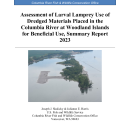
1211 SE Cardinal Court
Suite 100
Vancouver, WA 98683
United States
About Julie Harris
Julie’s main responsibilities are to conduct and support study design, data analysis, demographic modeling, and writing for studies completed at CRFWCO to support conservation and management of fish, fisheries, and aquatic habitats in the Columbia River Basin. Julie also provides statistical support to other fisheries professionals and to the National Wildlife Refuges Program. Julie is involved in information exchange and conservation of Pacific Lamprey. In addition, Julie is the coordinator of the CRFWCO monthly seminar series.
Program: Natural Population Assessment Passage and Habitat Assessment
Current Projects:
1. Examining patterns in Pacific Lamprey occupancy and abundance in the Columbia River Basin
2. Estimating vital rates to help assess the feasibility of stocking YY Males to eradicate Brook Trout from an isolated Washington stream
3. Identifying trends in abundance and distribution of birds in the Fitzner-Eberhardt Arid Lands Ecology Reserve on the Hanford Reach National Monument.
Past Projects:
1. Harris, J.E., J.J. Skalicky, T.L. Liedtke, L.K. Weiland, B.J. Clemens, and A.E. Gray. 2020. Effects of dewatering on behavior, distribution, and abundance of larval lampreys. River Research and Applications 36:2001-2012.
2. Harris, J.E. 2020. Assessing accuracy and bias of protocols to estimate age of Pacific salmon using scales. North American Journal of Fisheries Management 40:1007-1022.
3. Clemens, B.J., L. Weitkamp, K. Siwicke, J. Wade, J. Harris, J. Hess, L. Porter, K. Parker, T.M. Sutton, and A.M. Orlov. 2019. Marine biology of the Pacific lamprey Entosphenus tridentatus. Reviews in Fish Biology and Fisheries 29:767-788.
4. Harris, J.E., C. Newlon, P.J. Howell, R.C. Koch, and S.L. Haeseker. 2018. Modeling individual variability in growth of bull trout in the Walla Walla River Basin using a hierarchical von Bertalanffy growth model. Ecology of Freshwater Fish 27(1):103-115.
5. Harris, J.E., and J.C. Jolley. 2017. Estimation of occupancy, density, and abundance of larval lampreys in tributary river mouths upstream of dams on the Columbia River, Washington and Oregon. Canadian Journal of Fisheries and Aquatic Sciences74(6):843-852.
6. Hightower, J.E., and J.E. Harris. 2017. Estimating fish mortality rates using telemetry and multistate models. Fisheries 42(4):210-219.
At CRFWCO since: 2013




